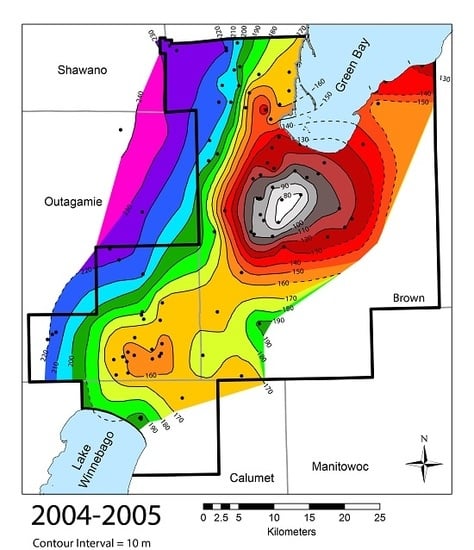Aquifer Drawdown and Recovery in the Northeast Groundwater Management Area, Wisconsin, USA: A Century of Groundwater Use
Abstract
:1. Introduction
1.1. Water Resources in Wisconsin
1.2. Sustainability and Groundwater Management Areas in Wisconsin
1.3. Purpose of the Research
2. Geologic and Geographic Setting
2.1. General Geography of Eastern Wisconsin
2.2. Geology and Hydrostratigraphy of Eastern Wisconsin
3. Methods
4. Early History of the Northeastern Wisconsin Groundwater Management Area (Predevelopment through Year 1998)
4.1. Predevelopment and Early Development Conditions of the Confined Sandstone Aquifer
4.2. Transition #1—1957–1960 Switch by City of Green Bay to Surface Water Pipeline
4.3. Regional Growth (1960–2000)
5. Recent History of the Northeastern Wisconsin Groundwater Management Area (1998–Present)
5.1. Formation of the Central Brown County Water Authority
5.2. Radium Regulations as the Driver for a Second Transition
5.3. Transition #2—2005 to Present Switch by Several Communities in Central Brown County
6. Discussion and Implications
6.1. Unintended Consequences
6.2. Current State of the Aquifer and Apparent Trends
6.3. Effects of Future Pumping Changes
6.4. Concerns over Arsenic and Sulfide Mineralization
6.5. Aquifer Sustainability
7. Conclusions
Supplementary Materials
Acknowledgments
Author Contributions
Conflicts of Interest
Abbreviations
| CBCWA | Central Brown County Water Authority |
| GBWU | Green Bay Water Utility |
| GMA | Groundwater Management Area |
| ML | Megaliters (millions of liters) |
| USEPA | United States Environmental Protection Agency |
| USGS | United States Geological Survey |
| SWL | Static Water Levels |
| WDNR | Wisconsin Department of Natural Resources |
| WGNHS | Wisconsin Geological & Natural History Survey |
| WUWN | Wisconsin Unique Well Number |
References
- Aeschbach-Hertig, W.; Gleeson, T. Regional strategies for the accelerating global problem of groundwater depletion. Nat. Geosci. 2012, 5, 853–861. [Google Scholar] [CrossRef]
- World Water Assessment Programme. The United Nations World Water Development Report 4: Managing Water under Uncertainty and Risk. Report No. 978-92-3-104235-5, 2012, 407 (UNESCO, 2012). Available online: http://www.unesco.org/new/fileadmin/MULTIMEDIA/HQ/SC/pdf/WWDR4%20Volume%201-Managing%20Water%20under%20Uncertainty%20and%20Risk.pdf (accessed on 9 January 2017).
- Hayashi, T.; Tokunaga, T.; Aichi, M.; Shimada, J.; Taniguchi, M. Effects of human activities and urbanization on groundwater environments: An example from the aquifer system of Tokyo and the surrounding area. Sci. Total Environ. 2009, 407, 3165–3172. [Google Scholar] [CrossRef] [PubMed]
- Visocky, A.P. Water-Level Trends and Pumpage in the Deep Bedrock Aquifers in the Chicago Region, 1991–1995; Illinois State Water Survey, Information Circular 182; Illinois State Water Survey: Champaign, IL, USA, 1997; p. 45. Available online: http://www.isws.illinois.edu/pubdoc/C/ISWSC-182.pdf (accessed on 9 January 2017).
- Luczaj, J.; Masarik, K. Groundwater quantity and quality issues in a water-rich region: Examples from Wisconsin, USA. Resources 2015, 4, 323–357. [Google Scholar] [CrossRef]
- Wisconsin Department of Natural Resources (WDNR). Wisconsin Water Use: 2013 Withdrawal Summary; Wisconsin Department of Natural Resources Water Use Section: Madison, WI, USA, 2014. Available online: http://dnr.wi.gov/topic/WaterUse/documents/WithdrawalReportDetail.pdf (accessed on 6 December 2016).
- Buchwald, C.A. Water Use in Wisconsin. United States Geological Survey Open File Report, 2009-1076; 2005; p. 74. Available online: https://pubs.usgs.gov/of/2009/1076/pdf/ofr20091076.pdf (accessed on 27 February 2017). [Google Scholar]
- Smail, R.A.; Wisconsin Department of Natural Resources, Madison, WI, USA. Personal communication regarding groundwater use in Wisconsin, 13 October 2014.
- Erb, K.; Ronk, E.; Koundinya, V.; Luczaj, J. Groundwater Quality Changes in a Karst Aquifer of Northeastern Wisconsin, USA: Reduction of Brown Water Incidence and Bacterial Contamination Resulting from Implementation of Regional Task Force Recommendations. Resources 2015, 4, 655–672. [Google Scholar] [CrossRef]
- Andren, A. Groundwater Drawdown. Wisconsin Water Resources Institute; p. 2. Available online: http://aqua.wisc.edu/publications/pdfs/GroundwaterDrawdown.pdf (accessed on 14 December 2016).
- Kananen, C.; Luczaj, J.A. Drawdown of the Potentiometric Surface in the Cambrian-Ordovician Aquifer in Marinette County, Wisconsin. In Proceedings of the American Water Resources Association—Wisconsin Section, 39th Annual Meeting, Oconomowoc, WI, USA, 5–6 March 2015; Available online: http://state.awra.org/wisconsin/2015meeting/AWRAProgram2015.pdf (accessed on 14 December 2016).
- Weidman, S.; Schultz, A.R. The Underground and Surface Water Supplies of Wisconsin; Wisconsin Geological and Natural History Survey: Madison, WI, USA, 1915. [Google Scholar]
- Knowles, D.B. Ground-Water Conditions in the Green Bay Area Wisconsin, 1950–1960. United States Geological Survey Water-Supply Paper, 1669-J; 1964; 37p. Available online: https://pubs.usgs.gov/wsp/1669j/report.pdf (accessed on 1 January 2017). [Google Scholar]
- Drescher, W.J. Ground-Water Conditions in Artesian Aquifers in Brown County Wisconsin; United States Geological Survey Water-Supply Paper 1190; USGS: Washington, DC, USA, 1953; p. 60.
- LeRoux, E.F. Geology and Ground-Water Resources of Outagamie County Wisconsin; United States Geological Survey Water-Supply Paper 1421; USGS: Washington, DC, USA, 1957; p. 57.
- Krohelski, J.T. Hydrogeology and Ground-Water Use and Quality, Brown County, Wisconsin; Wisconsin Geological and Natural History Survey: Madison, WI, USA, 1986; Volume 57, pp. 1–42. [Google Scholar]
- Batten, W.G.; Bradbury, K.R. Regional Groundwater Flow Systems between the Wolf and Fox Rivers near Green Bay, Wisconsin; Wisconsin Geological and Natural History Survey, Information Circular 75; WGNHS: Madison, WI, USA, 1996; pp. 1–28. [Google Scholar]
- Conlon, T.D. Hydrogeology and Simulation of Ground-Water Flow in the Sandstone Aquifer, Northeastern Wisconsin: U.S. Geological Survey Water-Resources Investigations Report 97-4096; USGS: Washington, DC, USA, 1998; p. 60.
- Emmons, P.J. An Evaluation of the Bedrock Aquifer System in Northeastern Wisconsin; United States Geological Survey Water-Resources Investigations Report 85-4199; USGS: Washington, DC, USA, 1987; p. 48.
- Walker, J.F.; Daad, D.A.; Krohelski, J.T. Optimization of Ground-Water Withdrawal in the Lower Fox River Communities, Wisconsin; United States Geological Survey Water-Resources Investigations Report 97-4218; USGS: Washington, DC, USA, 1998; p. 24.
- Feinstein, D.T.; Hunt, R.J.; Reeves, H.W. Regional Groundwater-Flow Model of the Lake Michigan Basin in Support of Great Lakes Basin Water Availability and Use Studies: U.S. Geological Survey Scientific Investigations Report 2010-5109; USGS: Washington, DC, USA, 2010; p. 379.
- Luczaj, J.A. Preliminary Geologic Map of the Buried Bedrock Surface, Brown County, Wisconsin. Wisconsin Geological and Natural History Survey Open File Report. 2011. WOFR2011-02, 1:100000 Scale Map Sheet. Available online: https://wgnhs.uwex.edu/pubs/download_wofr201102/ (accessed on 6 December 2016).
- Brown, B.A. Preliminary Bedrock Geologic Map of Outagamie County, Wisconsin. Wisconsin Geological and Natural History Survey Open File Report. 2005. WOFR2005-02, 1:100000 Scale Map Sheet. Available online: http://wgnhs.uwex.edu/pubs/download_wofr200502/ (accessed on 16 January 2017).
- Luczaj, J.A. Geology of the Niagara escarpment in Wisconsin. Geosci. Wis. 2013, 22, 1–34. [Google Scholar]
- Luczaj, J.A.; Hart, D.J. Drawdown in the northeast Groundwater Management Area (Brown, Outagamie, and Calumet Counties, WI); WDNR: Madison, WI, USA, 2009; Available online: http://wgnhs.uwex.edu/pubs/wofr200904/ (accessed on 6 December 2016).
- Maas, J.C. Drawdown, Recovery, and Hydrostratigraphy in Wisconsin’s Northeast Groundwater Management Area (Brown, Outagamie, and Calumet Counties). Master’s Thesis, University of Wisconsin, Green Bay, WI, USA, 2009. [Google Scholar]
- Grundl, T.; Magnusson, N.; Brennwald, M.S.; Kipfer, R. Mechanisms of subglacial groundwater recharge as derived from noble gas, 14C, and stable isotopic data. Earth Planet. Sci. Lett. 2013, 369–370, 78–85. [Google Scholar] [CrossRef]
- Baeten, J.B. Spatial Distribution and Source Identification of Dissolved Strontium in Eastern Wisconsin’s Cambrian-Ordovician Aquifers. Master’s Thesis, University of Wisconsin-Green Bay, Green Bay, WI, USA, 2015. [Google Scholar]
- Hamby, A.; Luczaj, J.; Baeten, J. Exploring the Significance of Faults and Fractures in the Confined Aquifer in Northeastern Wisconsin (Brown and Outagamie Counties): Insights from Stable Isotope Patterns. In Proceedings of the American Water Resources Association—Wisconsin Section, 39th Annual Meeting, Oconomowoc, WI, USA, 5–6 March 2015; Available online: http://state.awra.org/wisconsin/2015meeting/AWRAProgram2015.pdf (accessed on 16 January 2017).
- Wisconsin State Legislature. 2003 WISCONSIN ACT 310. 281.34 Groundwater Withdrawals (9). Available online: https://docs.legis.wisconsin.gov/2003/related/acts/310 (accessed on 14 December 2016).
- NOAA—National Weather Service, Index of Climate Images for Wisconsin. Available online: http://www.crh.noaa.gov/images/mkx/climate/ (accessed on 6 December 2016).
- United States Census Bureau. United States Census—2010. Available online: http://www.census.gov/2010census/data/ (accessed on 6 December 2016).
- Need, E.A. Pleistocene Geology of Brown County, Wisconsin; Wisconsin Geological and Natural History Survey Information Circular 48; WGNHS: Madison, WI, USA, 1985; p. 19. [Google Scholar]
- Moeller, C.A.; Hooyer, T.S.; Batten, W.G. Investigating recharge to bedrock aquifers through fine grained glacial deposits in east-central Wisconsin, Van Straten property, Outagamie County. In Late-Glacial History of East-Central Wisconsin. Wisconsin Geological and Natural History Survey Open File Report 2007-1; Hooyer, T.S., Ed.; WGNHS: Madison, WI, USA, 2007; pp. 21–26. [Google Scholar]
- Luczaj, J.A.; McIntire, M.; Olson Hunt, M.J. Geochemical characterization of Trace MVT mineralization in Paleozoic Sedimentary Rocks of Northeastern Wisconsin, USA. Geosciences 2016, 6, 29. [Google Scholar] [CrossRef]
- Mai, H.; Dott, R.H., Jr. A Subsurface Study of the St. Peter Sandstone in Southern and Eastern Wisconsin; Wisconsin Geological and Natural History Survey, Information Circular IC-47; WGNHS: Madison, WI, USA, 1985; p. 26. [Google Scholar]
- Syverson, K.M.; Clayton, L.; Attig, J.W.; Mickelson, D.M. Lexicon of Pleistocene Stratigraphic Units of Wisconsin; Technical Report; Wisconsin Geological and Natural History Survey: Madison, WI, USA, 2011; pp. 1–180. [Google Scholar]
- Mudrey, M.G.; Brown, B.A.; Greenberg, J.K. Bedrock Geologic Map of Wisconsin, 1:1,000,000 Scale Map Sheet. University of Wisconsin-Extension; Wisconsin Geological and Natural History Survey: Madison, WI, USA, 1982. [Google Scholar]
- Smail, R.A.; Wisconsin Department of Natural Resources, Madison, WI, USA. Personal Communication regarding pumping rates for municipal wells in Wisconsin, 22 December 2015.
- Wisconsin Department of Natural Resources. Wisconsin Well Construction Reports Plus Other Related Files; Filemaker Pro Database on Compact Disc; WDNR: Madison, WI, USA, 2016.
- United States Geological Survey. USGS Groundwater Watch, Active Groundwater Level Network. Available online: https://groundwaterwatch.usgs.gov/default.asp (accessed on 16 January 2017).
- Burch, S.L. A Comparison of Potentiometric Surfaces for the Cambrian-Ordovician Aquifers of Northeastern Illinois, 2000 and 2007; Illinois State Water Survey Institute of Natural Resource Sustainability; University of Illinois at Urbana-Champaign Data/Case Study 2008-04: Champaign, IL, USA, 2008; p. 49. [Google Scholar]
- Smail, R.A.; Wisconsin Department of Natural Resources, Madison, WI, USA. Personal Communication on water levels in municipal wells in Wisconsin, 22 March 2016.
- Smail, R.A.; Wisconsin Department of Natural Resources, Madison, WI, USA. Personal Communication on water levels in municipal wells in Wisconsin, 20 September 2016.
- Green Bay Press Gazette. Mayor Candidates Give Views on Water Question. 3 March 1955. [Google Scholar]
- Cruz-Uribe, B.; University of Wisconsin–Green Bay, Green Bay, WI, USA. Personal Communication regarding historical water use in Green Bay, 8 June 2009.
- Judge, Brown, J. Denning and another v. City of Green Bay and others. Wisconsin Supreme Court Ruling, 8 November 1955. 271 Wis.230; 72 N.W.2d 730; 1955 Wisc. Lexis 326. Available online: http://law.justia.com/cases/wisconsin/supreme-court/1955/271-wis-230-4.html (accessed on 4 March 2017).
- Donohue & Associates, Inc. Letter to Brown County Planning Commission regarding effects of 10 Mgal./day pumping by the City of Green Bay. 1 April 1977. [Google Scholar]
- Central Brown County Water Authority. History of the CBCWA. Available online: http://www.cbcwa.com/history.html (accessed on 16 January 2017).
- Thornburg, K.; Sahai, N. Arsenic occurrence, mobility, and retardation in sandstone and dolomite formations of the Fox River Valley, Eastern Wisconsin. Environ. Sci. Technol. 2004, 38, 5087–5094. [Google Scholar] [CrossRef] [PubMed]
- Burkel, R.S.; Stoll, R.C. Naturally occurring arsenic in sandstone aquifer water supply wells of Northeastern Wisconsin. Groundw. Monit. Remediat. 1999, 19, 114–121. [Google Scholar] [CrossRef]
- Egan, D. Water fight anything but neighborly; Dueling pipelines show urban-suburban mistrust. Milwaukee Journal Sentinel, 11 February 2006. [Google Scholar]
- Vaclavik, D.; Central Brown County Water Authority, Green Bay, WI, USA. Personal Communication, 10 January 2017.
- Morris, B.L.; Lawrence, A.R.L.; Chilton, P.J.C.; Adams, B.; Calow, R.C.; Klinck, B.A. Groundwater and Its Susceptibility to Degradation: A Global Assessment of the Problem and Options for Management; Early Warning and Assessment Report Series, RS. 03-3; UN Environment Programme: Nairobi, Kenya, 2003. [Google Scholar]
- Luczaj, J.A. The largest flowing artesian well in the state of Wisconsin is (sometimes) an abandoned deep quarry. In Proceedings of the American Water Resources Association—Wisconsin Section, 38th Annual Meeting, Wisconsin Dells, WI, USA, 13–14 March 2014; Available online: http://state.awra.org/wisconsin/2014meeting/Session3A4Luczaj.pdf (accessed on 6 December 2016).
- Ferris, G.; Northeast Asphalt, Inc., Greenville, WI, USA. Personal communication, 15 June 2016.
- Anderson, D.; Vincent, Urban, Walker, & Associates, Green Bay, WI, USA. Personal communication, 13 July 2016.
- Freiburg, J.T.; Fouke, B.W.; Lasemi, Z. New Insights on Upper Mississippi Valley Mineralization Based on Solution Cavities in the Ordovician Galena Group at the Conco Mine, North Aurora, Illinois, USA; Circular 581; Illinois State Geological Survey: Champaign, IL, USA, 2012. [Google Scholar]
- O’Rourke, J. Personal communication, 11 January 2012.
- Roork, D. Personal communication, 4 August 2015.
- Brown County Government. Brown County Register of Deeds Plat Book, Greene and Vroman’s Subdivision No. 1; Brown County Government (Wisconsin): Green Bay, WI, USA, 1899.
- Anderson, W.; Wisconsin Department of Natural Resources, Madison, WI, USA. Personal communication, 3 January 2017.
- Gotkowitz, M.B.; Schreiber, M.S.; Simo, J.A. Effects of water use on arsenic release to well water in a confined aquifer. Ground Water 2004, 42, 568–575. [Google Scholar] [CrossRef] [PubMed]
- Luczaj, J.A. Detection and Evaluation of an Inadvertent Cross-Connection of a Water Supply Pipeline to a Municipal Backup Well: A Cautionary Case Study of Heavy Metals Release. In Proceedings of the American Water Works Association—Wisconsin Section Meeting, Plover, WI, USA, 22 February 2017.
- Hamby, A. The Effects of Faults and Changing Water Levels on Confined Aquifer Water Chemistry in Northeastern Wisconsin. Ongoing Master’s Thesis, University of Wisconsin, Green Bay, WI, USA.
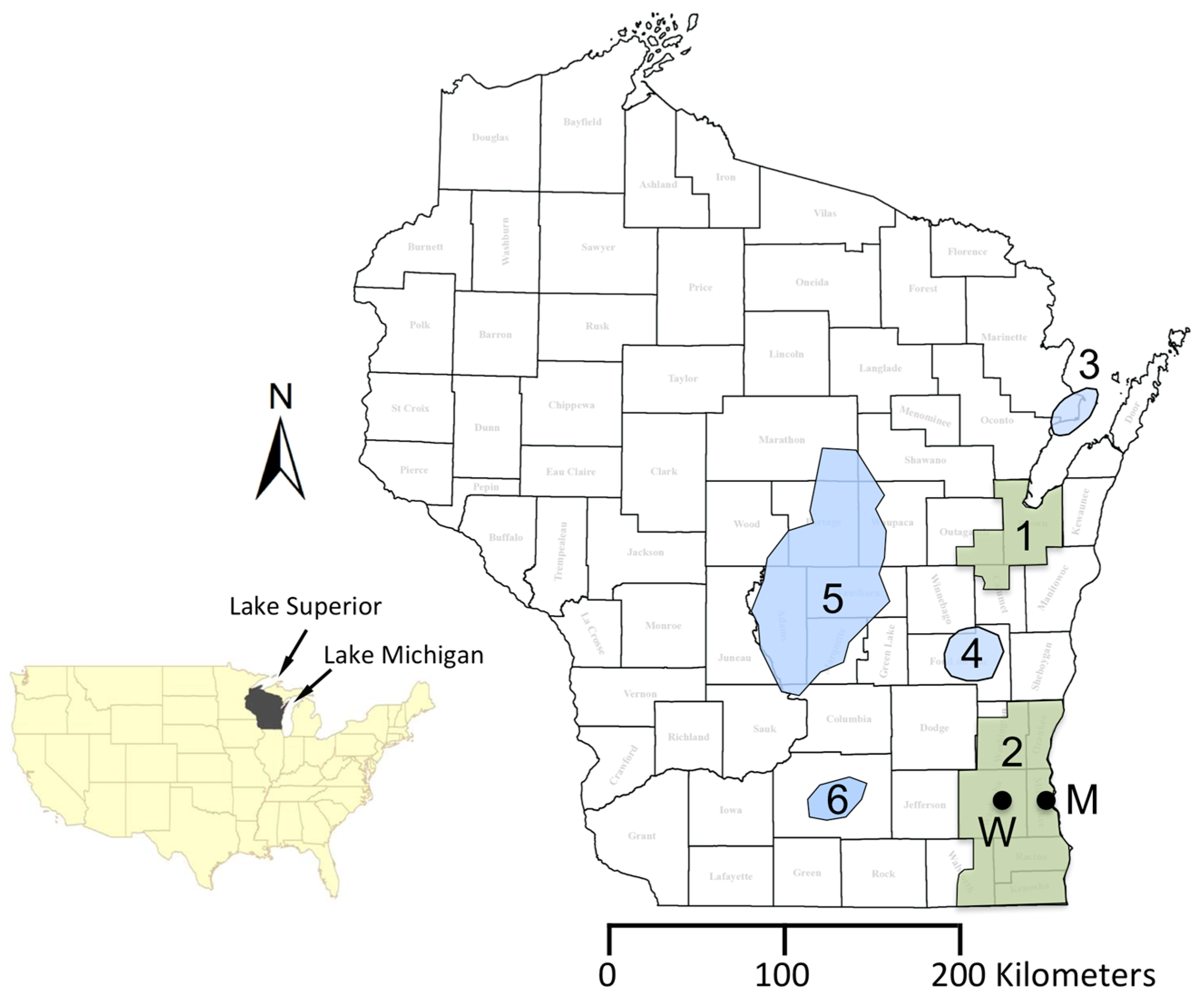
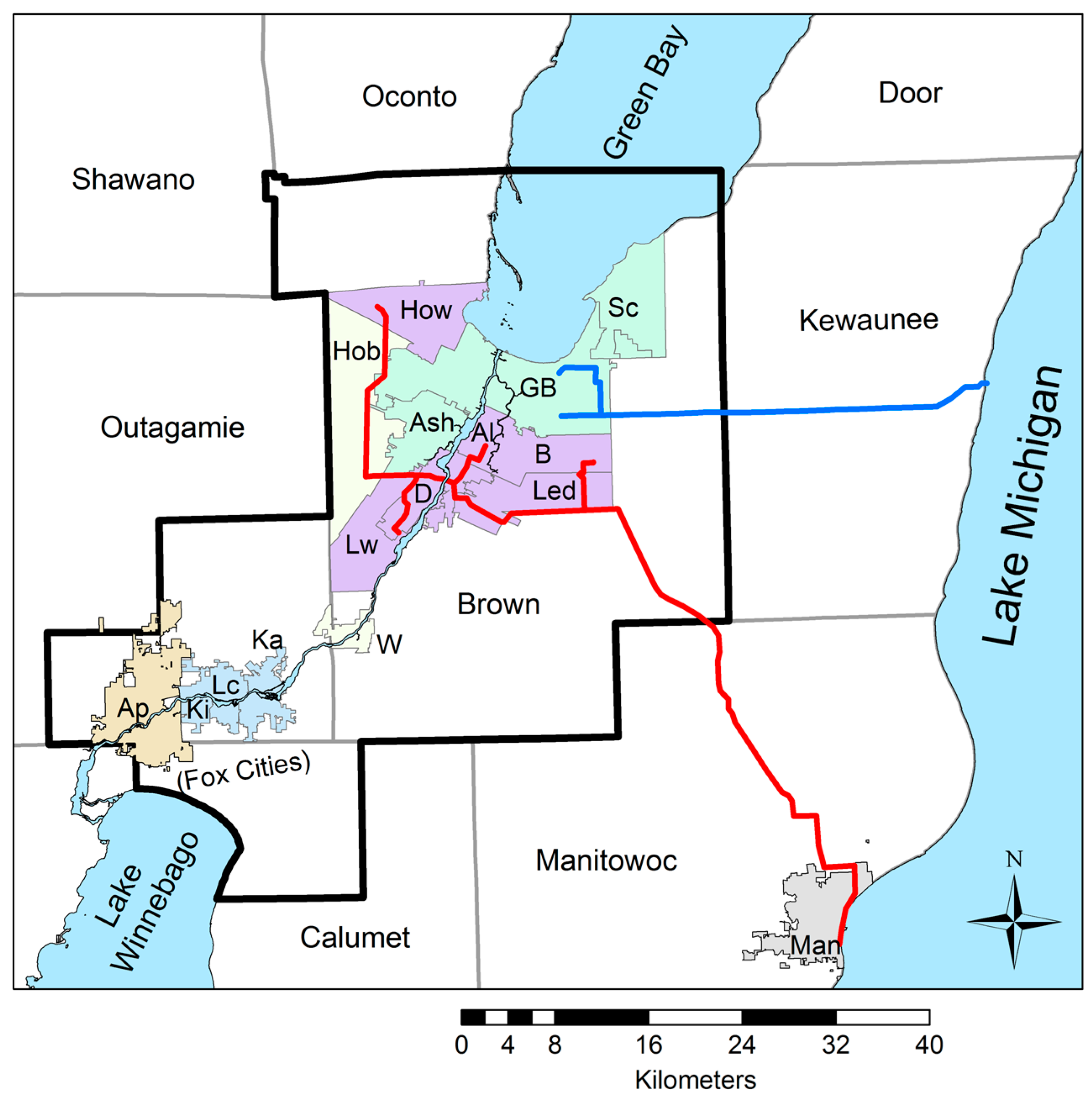

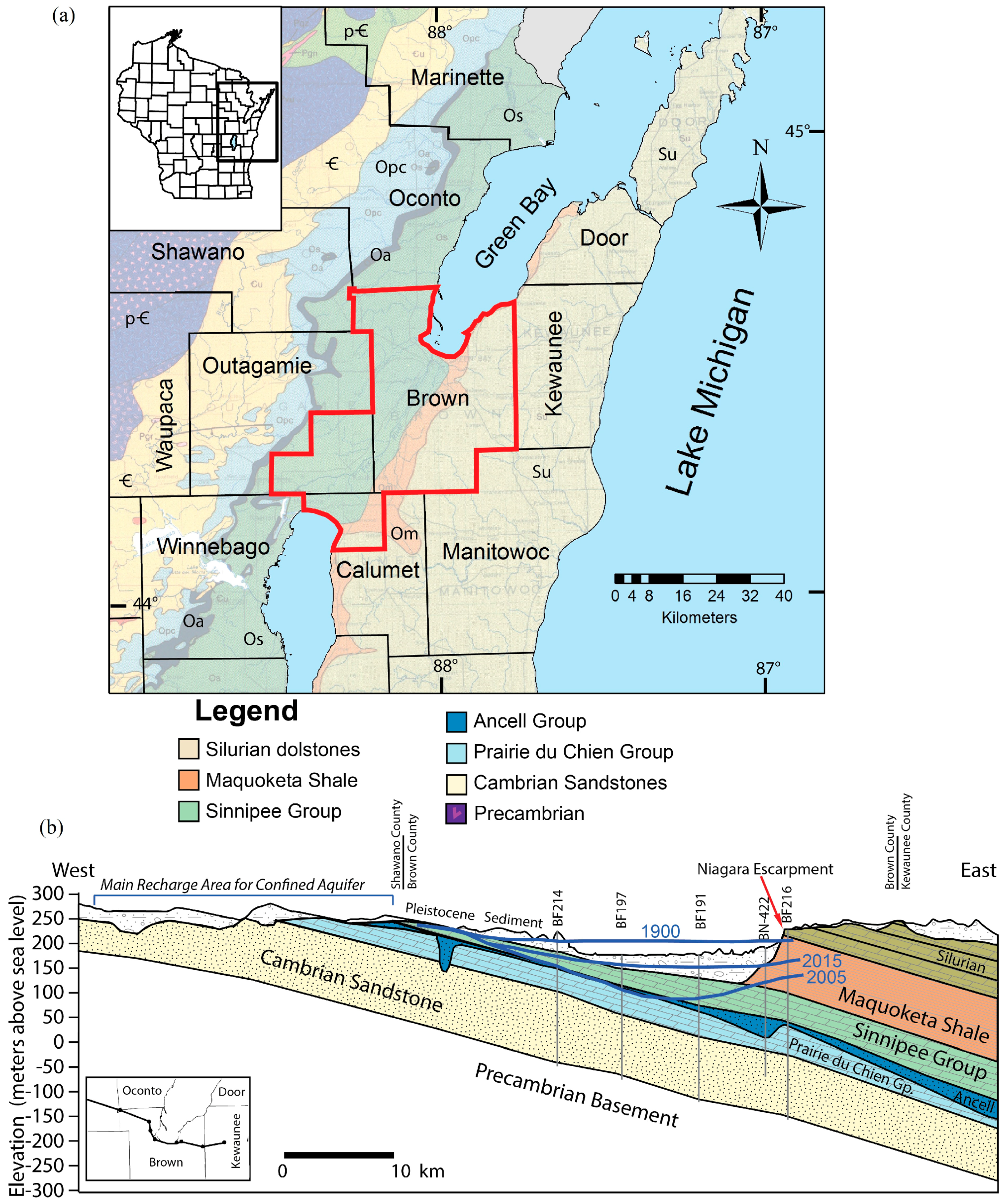
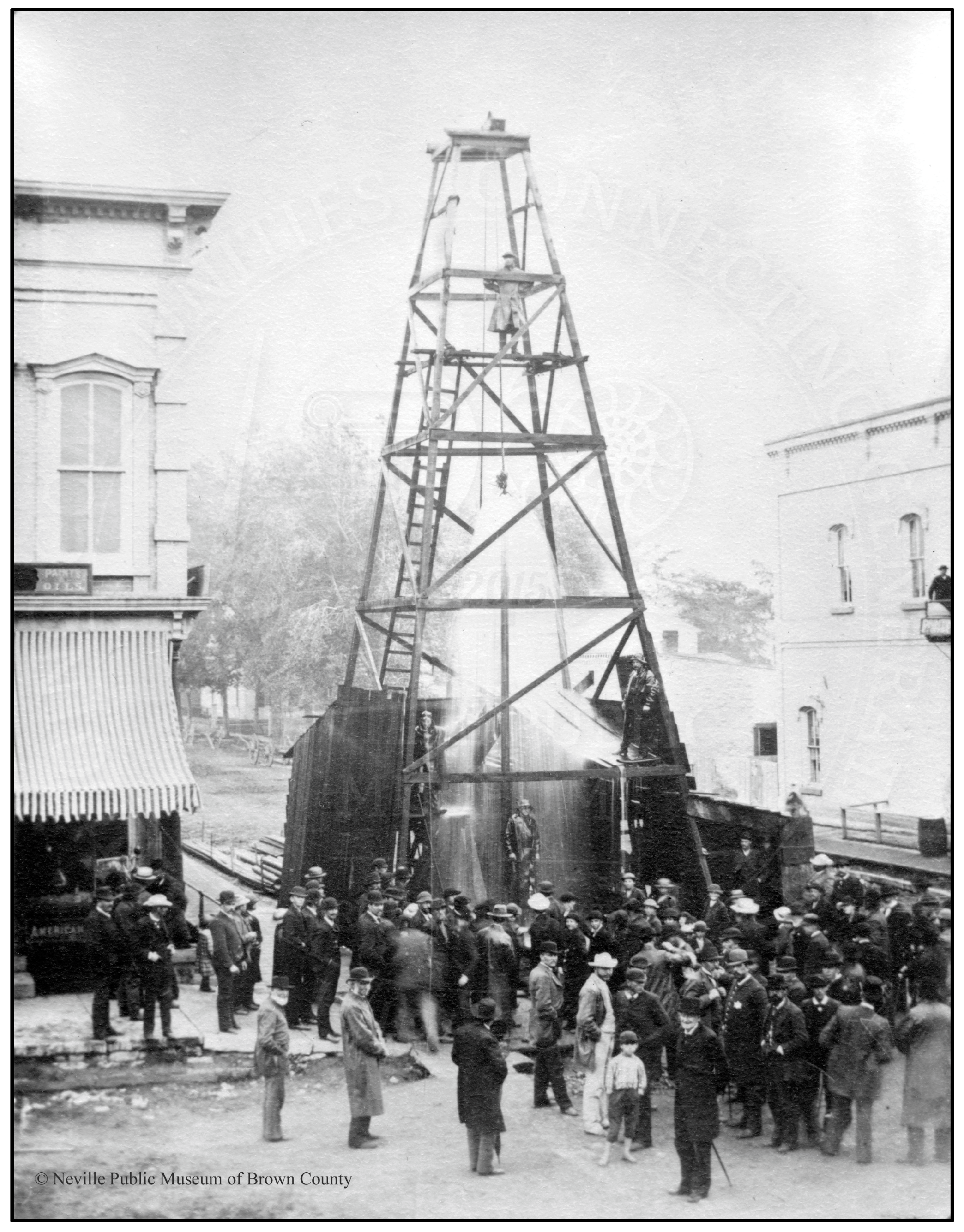
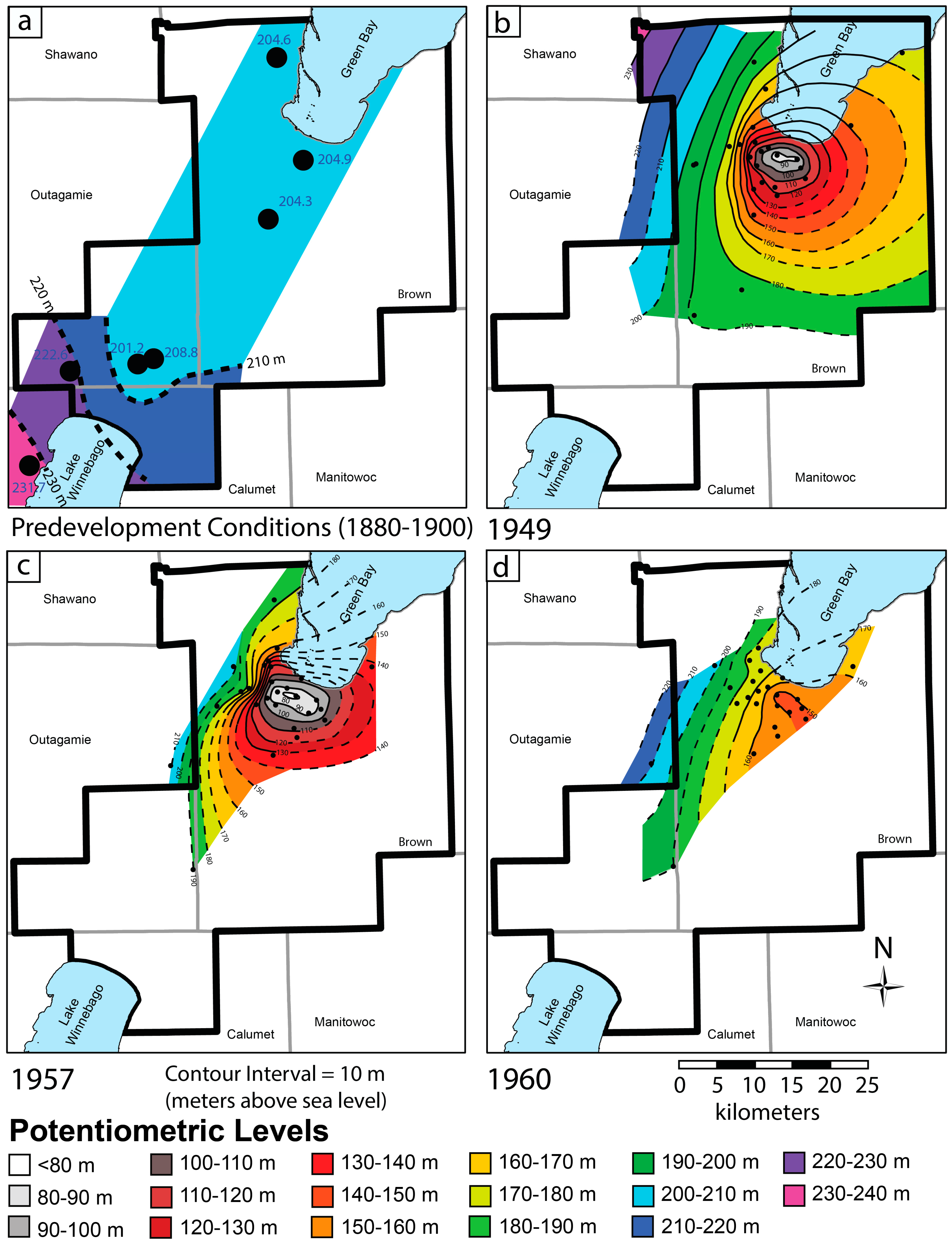
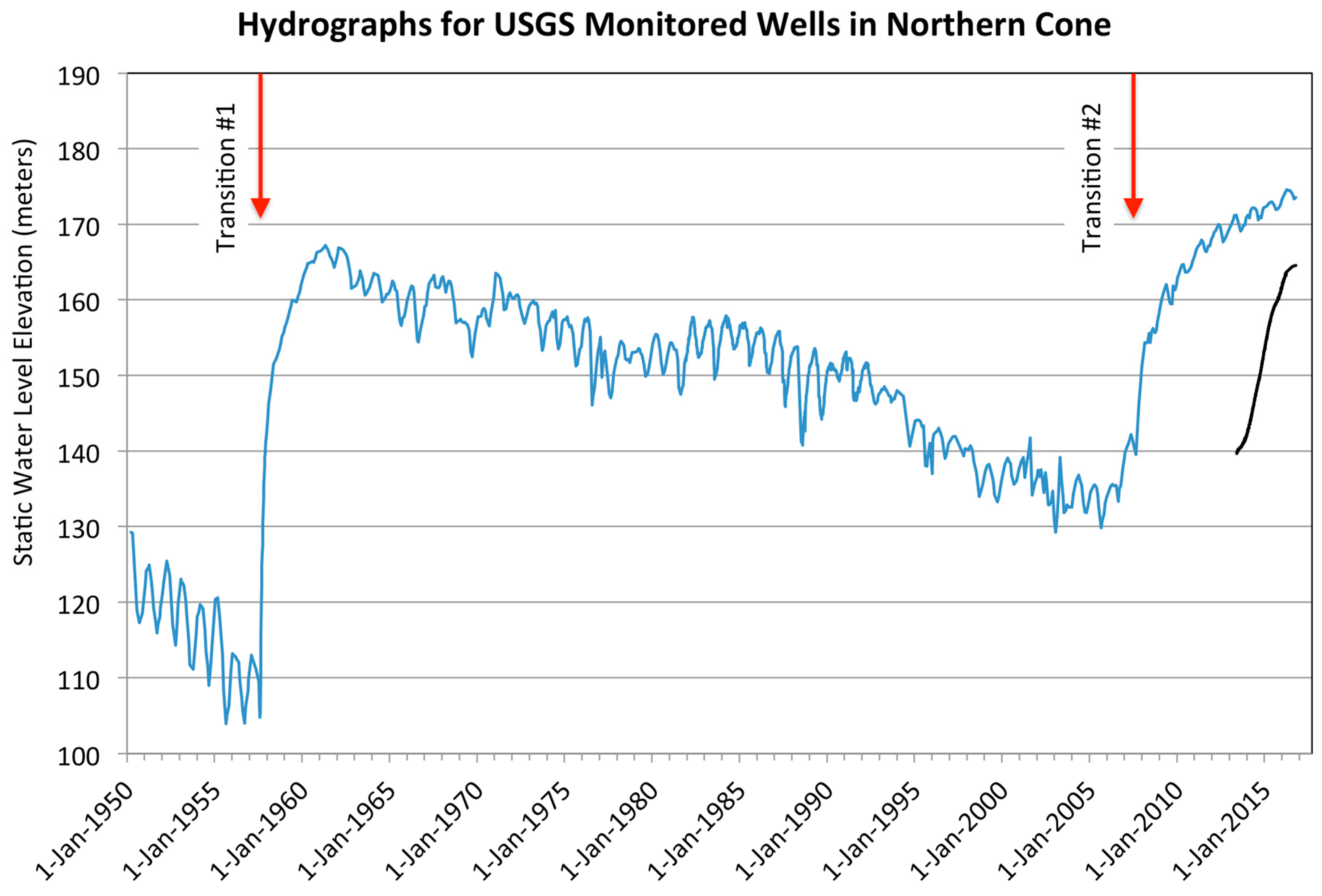
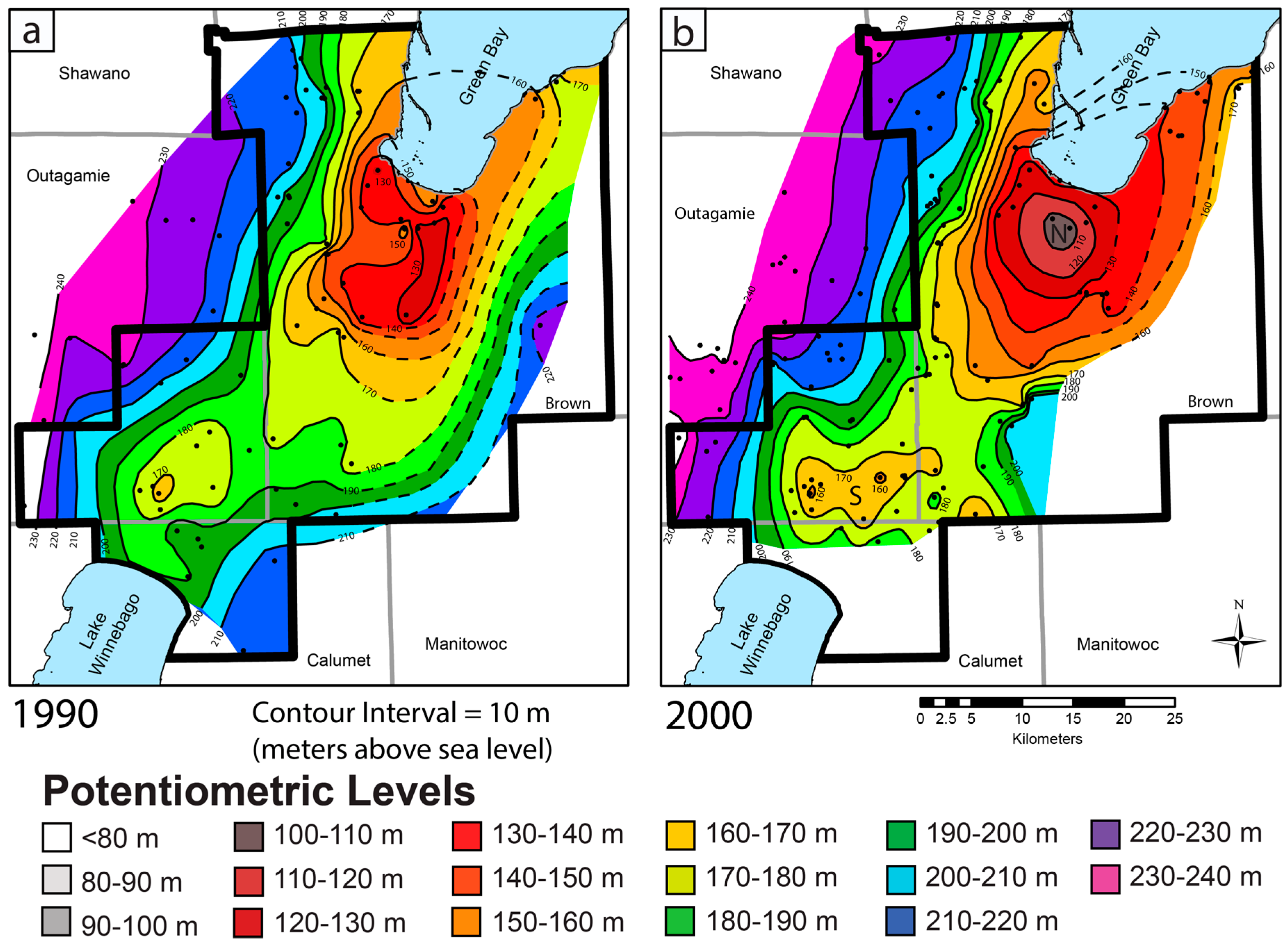
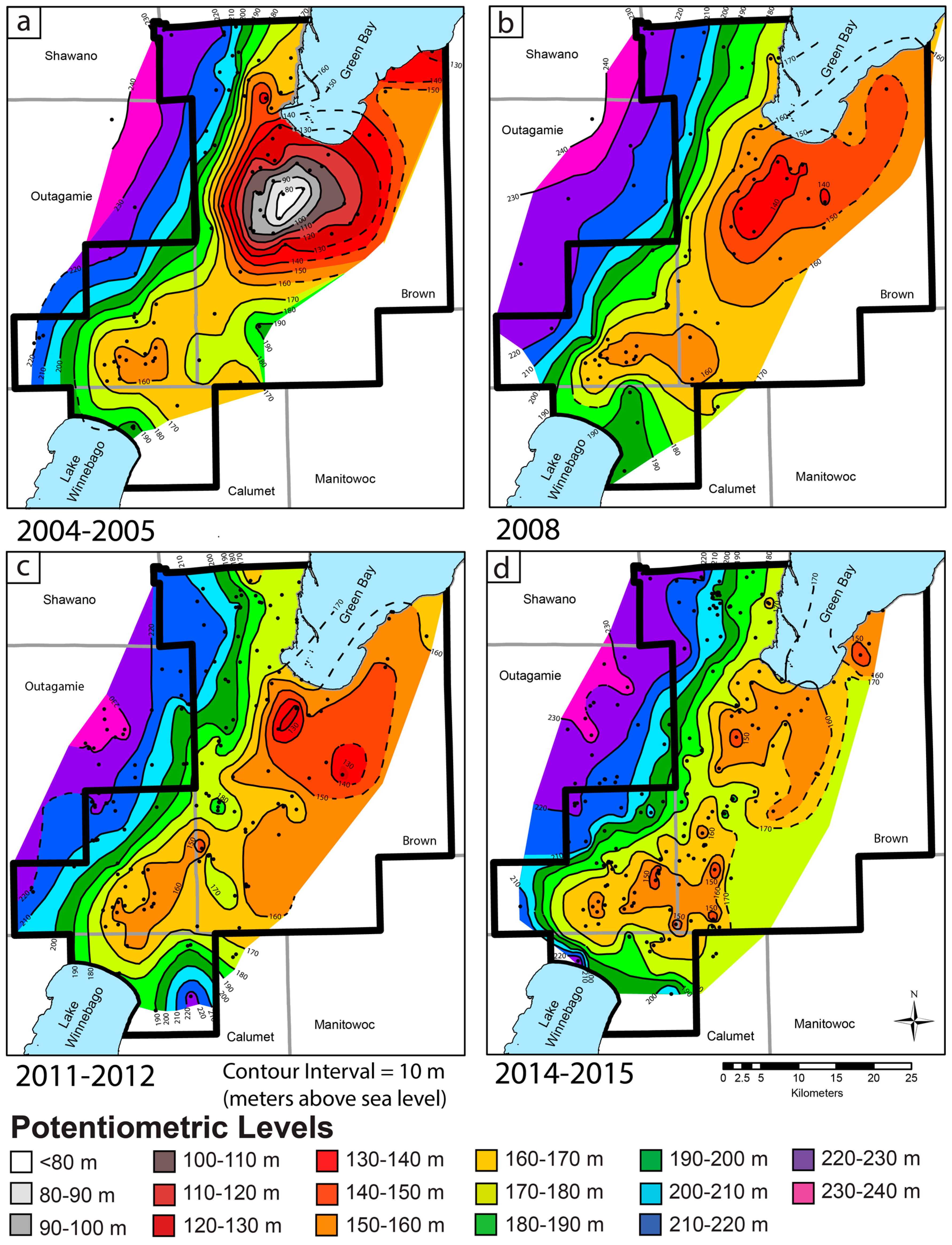
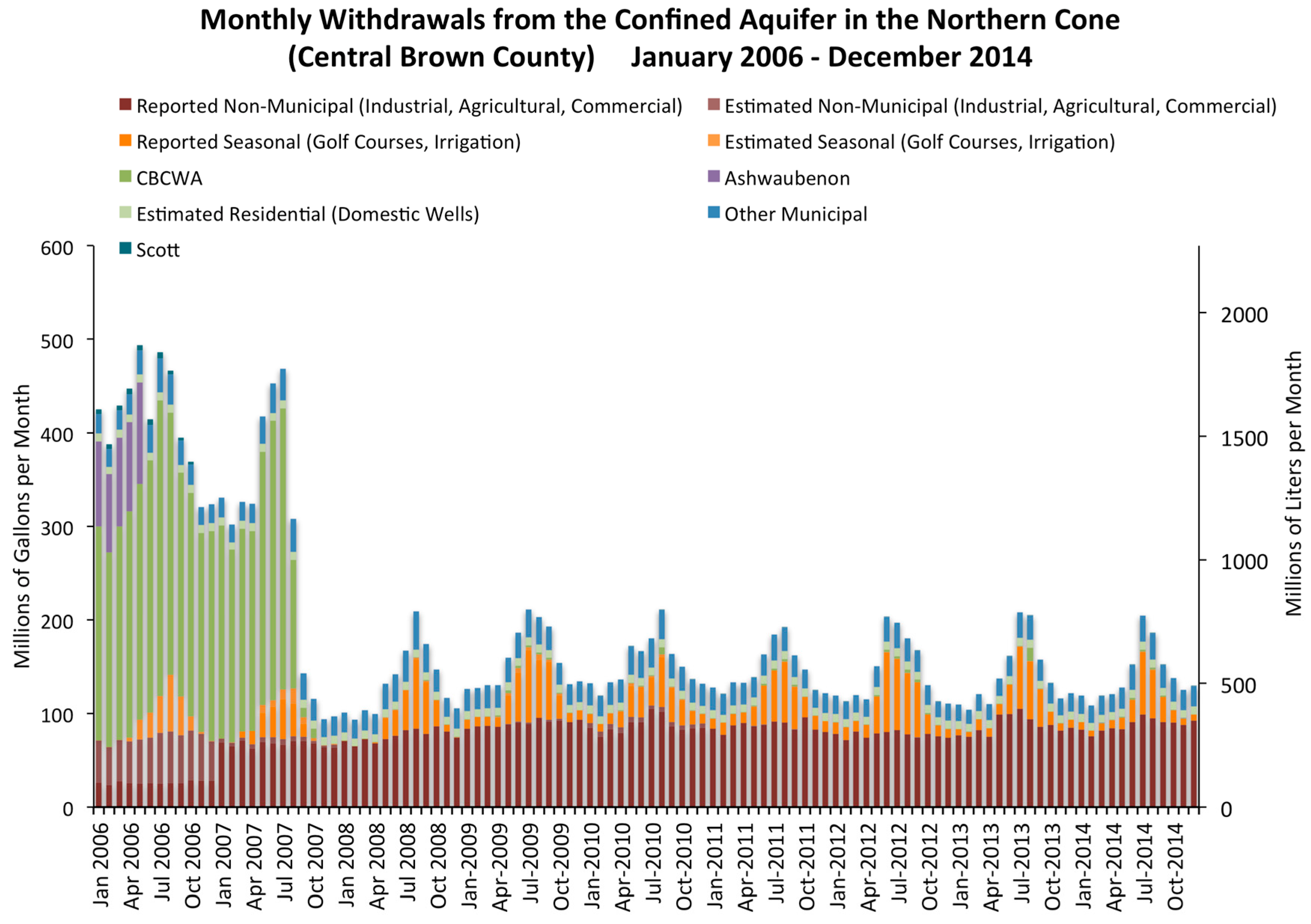

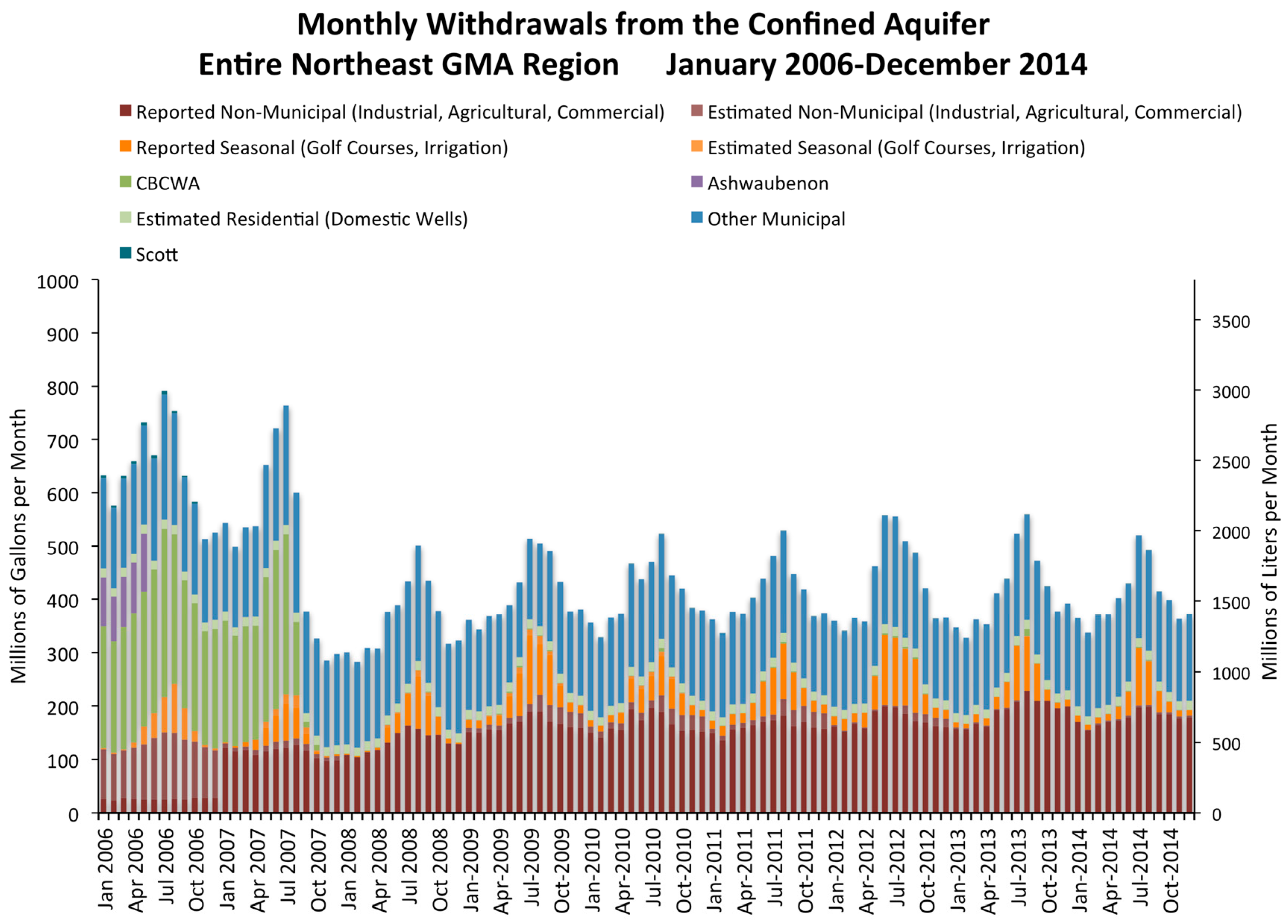

| Geologic Age | Geologic Unit (Thickness, Meters) | Lithology | Hydrostratigraphic Unit | |
|---|---|---|---|---|
| Cenozoic | Quaternary (Pleistocene) | Unconsolidated deposits (0–60 m) Locally > 100 m | Lacustrine silt and clay, glacial till, fluvial sand and gravel, and other deposits. | Local unconfined aquifer (sand and gravel; Kh = 4.1 × 10−3 cm/s) or regional confining unit (lacustrine clays and glacial till; Kv = 2.5 × 10−6 cm/s) |
| Paleozoic | Silurian | Undifferentiated (0–150 m) | Dolostone; fractured and karsted in many locations. | Upper Aquifer; Karsted in many locations of northeastern Wisconsin. (Kh = 3.4 × 10−3 cm/s) |
| Ordovician | Maquoketa Formation (0–150 m) | Shale, dolomitic shale, and dolomite. | Confining Units; Sinnipee Group Carbonates are locally used as aquifers for domestic use. (Kv = 1.2 × 10−8 cm/s) | |
| Sinnipee Group (120 m) | Dolostone with some shale. | |||
| Ancell Group (0–100 m) | Silty sandstone, fine- to medium-grained sandstone, sandy shale. Fills paleovalleys. | Upper Unit of the Confined Sandstone Aquifer (Kh = 1.7 × 10−3 cm/s) | ||
| Prairie du Chien Group (0–60 m) | Dolostone with varying amounts of oolitic chert and minor interbedded sandstone. | Generally an aquitard relative to the adjacent sandstones in eastern Wisconsin, but locally an aquifer for domestic use. | ||
| Cambrian | Trempealeau Group (0–15 m) | Fine- to medium-grained sandstone with some silty glauconitic dolomite. | Lower Unit of the Confined Sandstone Aquifer (Kh = 5.3 × 10−4 cm/s; up to Kh = 2.9 × 10−3 cm/s for the Elk Mound Group) | |
| Tunnel City Group (30–46 m) | Fine- to medium-grained sandstone, silty sandstone to sandy dolomite. Abundant glauconite commonly observed. | |||
| Elk Mound Group (75–90 m) | Very-fine to coarse-grained sandstone. | |||
| Precambrian | Precambrian | Undifferentiated | Crystalline rock, predominantly red granite, contains igneous and metamorphic rock. Limited sedimentary rocks (sandstone, dolostone) | Yields little to no water in many cases. Not used as an aquifer in the Northeast GMA. |
| Category | Volume (ML/day) | Percent of Total (October–March) | Percent of Total (April–September) |
|---|---|---|---|
| Municipal | 49.6 | 83.0 | 77.1 |
| Industrial | 9.1 | 15.2 | 14.1 |
| Seasonal (Irrigation) 1 | 0.0–4.5 | <1 | 7.1 |
| Residential | 1.06 | 1.8 | 1.7 |
| Total: | 59.73–64.28 (ave. 62.23) 2 | 100 | 100 |
| Category | Volume (ML/day) | Percent of Total (October–March) | Percent of Total (April–September) |
|---|---|---|---|
| Municipal | 3.14 | 23.6 | 17.6 |
| Industrial | 9.1 | 68.4 | 51.0 |
| Seasonal (Irrigation) 1 | 0.0–4.5 | <1 | 25.5 |
| Residential | 1.06 | 8.0 | 5.9 |
| Total: | 13.29–17.83 (ave. 15.86) 2 | 100 | 100 |
© 2017 by the authors. Licensee MDPI, Basel, Switzerland. This article is an open access article distributed under the terms and conditions of the Creative Commons Attribution (CC BY) license ( http://creativecommons.org/licenses/by/4.0/).
Share and Cite
Luczaj, J.A.; Maas, J.; Hart, D.J.; Odekirk, J. Aquifer Drawdown and Recovery in the Northeast Groundwater Management Area, Wisconsin, USA: A Century of Groundwater Use. Geosciences 2017, 7, 11. https://doi.org/10.3390/geosciences7010011
Luczaj JA, Maas J, Hart DJ, Odekirk J. Aquifer Drawdown and Recovery in the Northeast Groundwater Management Area, Wisconsin, USA: A Century of Groundwater Use. Geosciences. 2017; 7(1):11. https://doi.org/10.3390/geosciences7010011
Chicago/Turabian StyleLuczaj, John A., Julie Maas, David J. Hart, and Jonathan Odekirk. 2017. "Aquifer Drawdown and Recovery in the Northeast Groundwater Management Area, Wisconsin, USA: A Century of Groundwater Use" Geosciences 7, no. 1: 11. https://doi.org/10.3390/geosciences7010011





